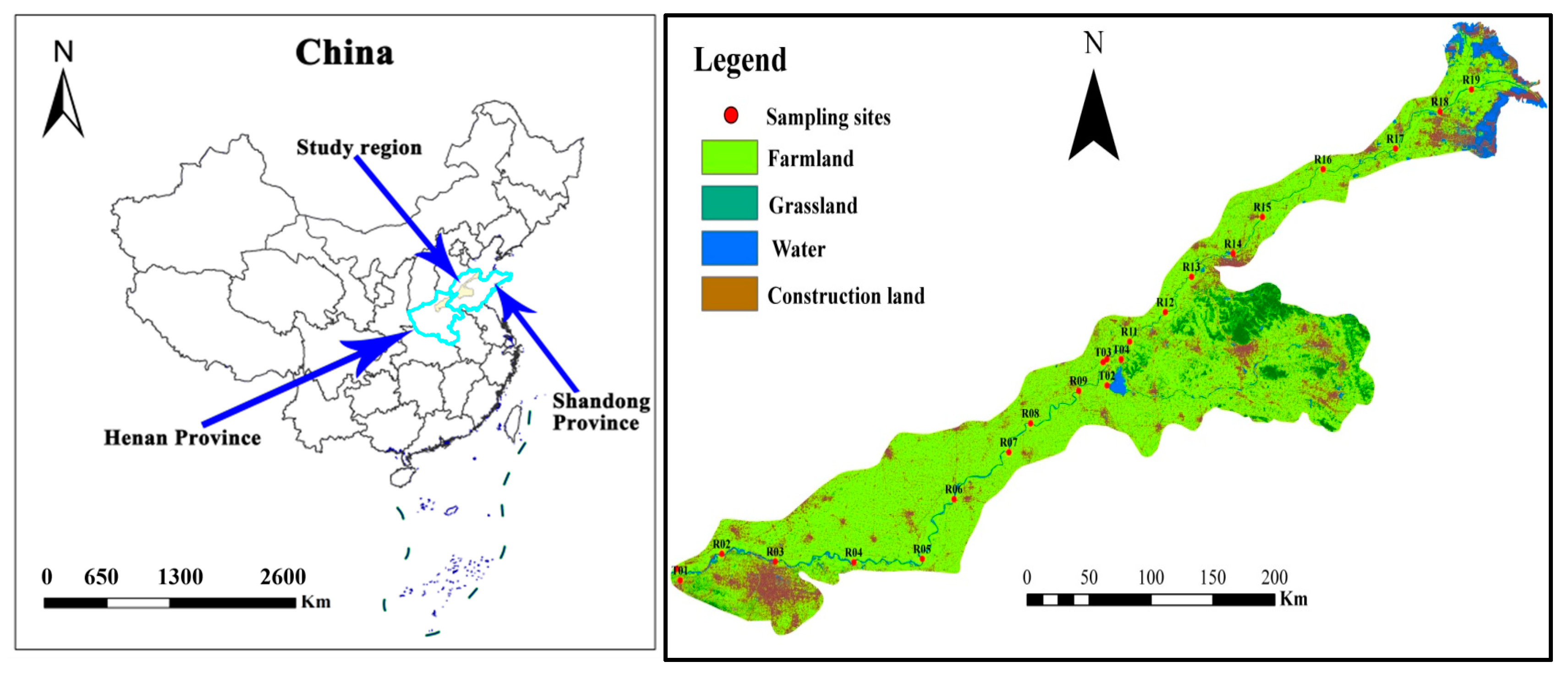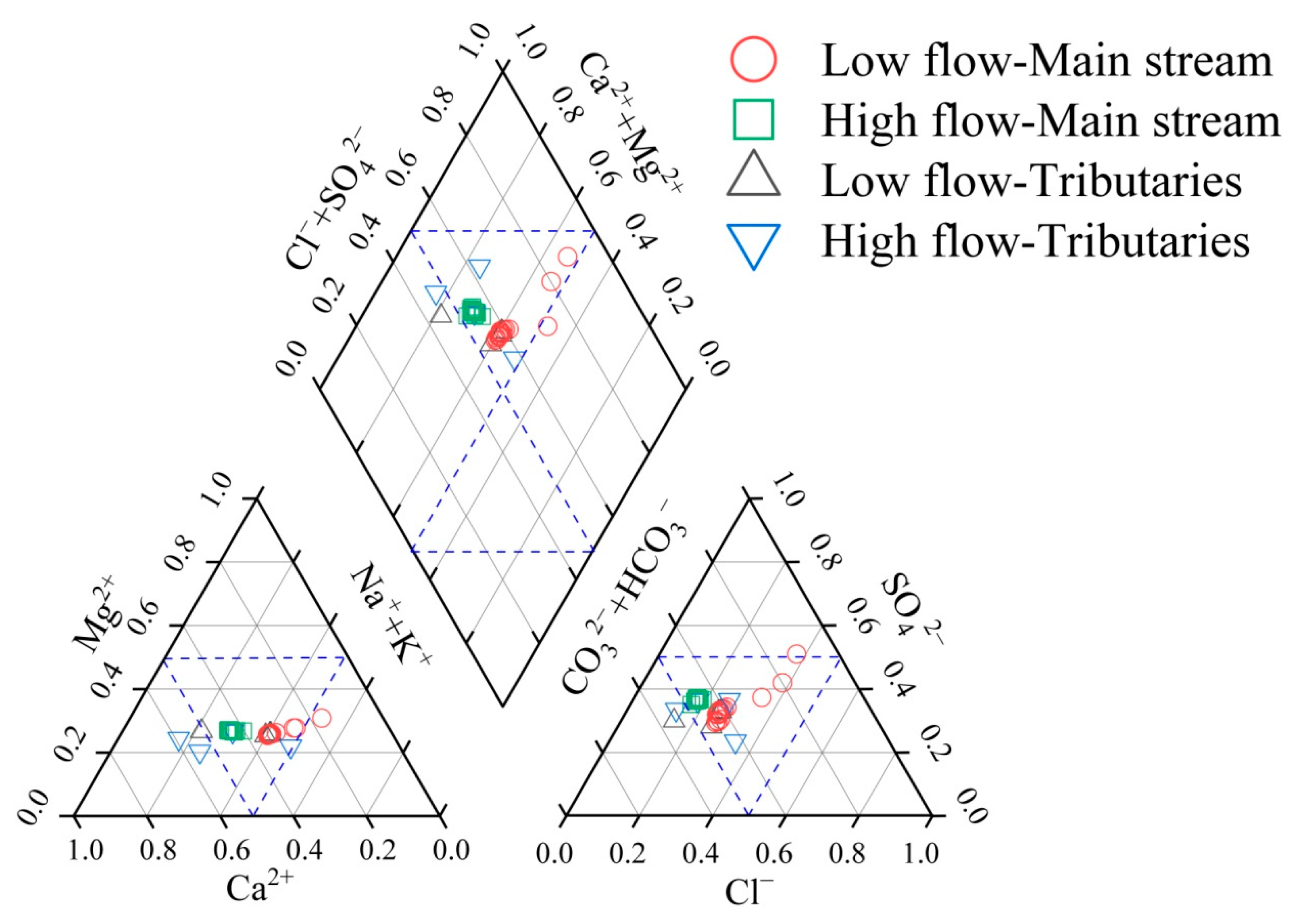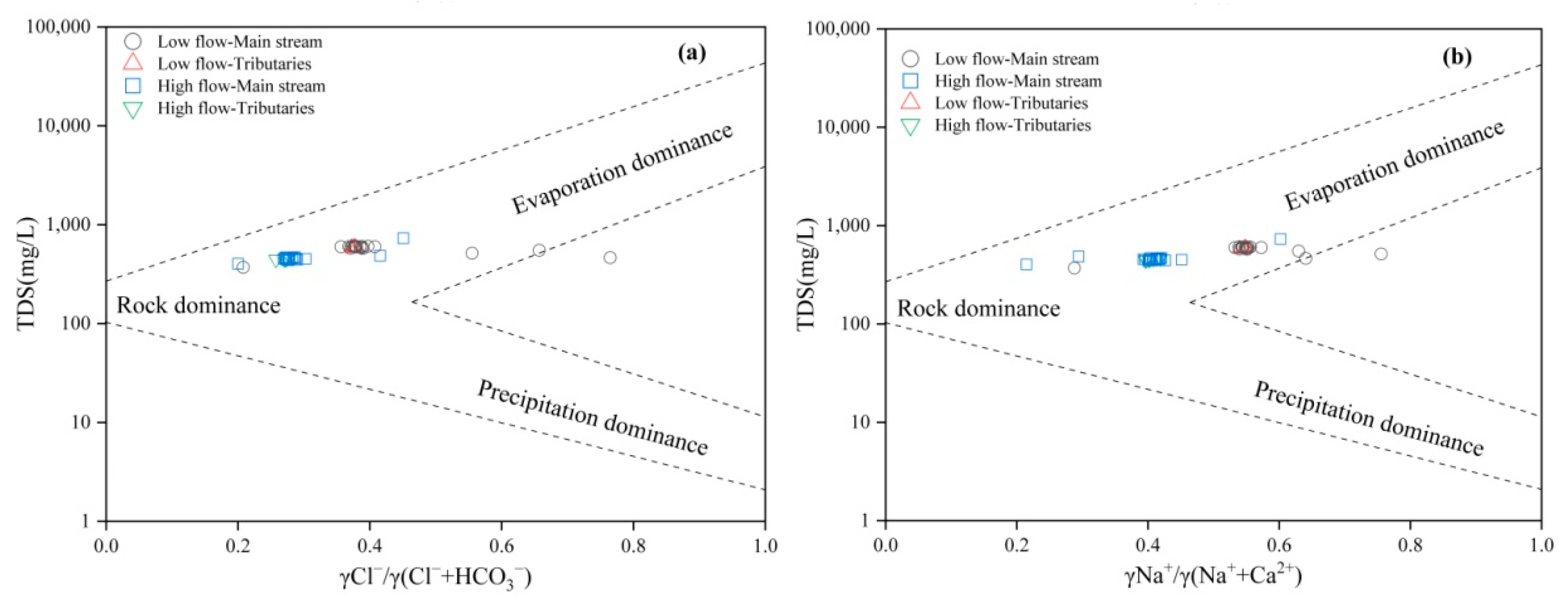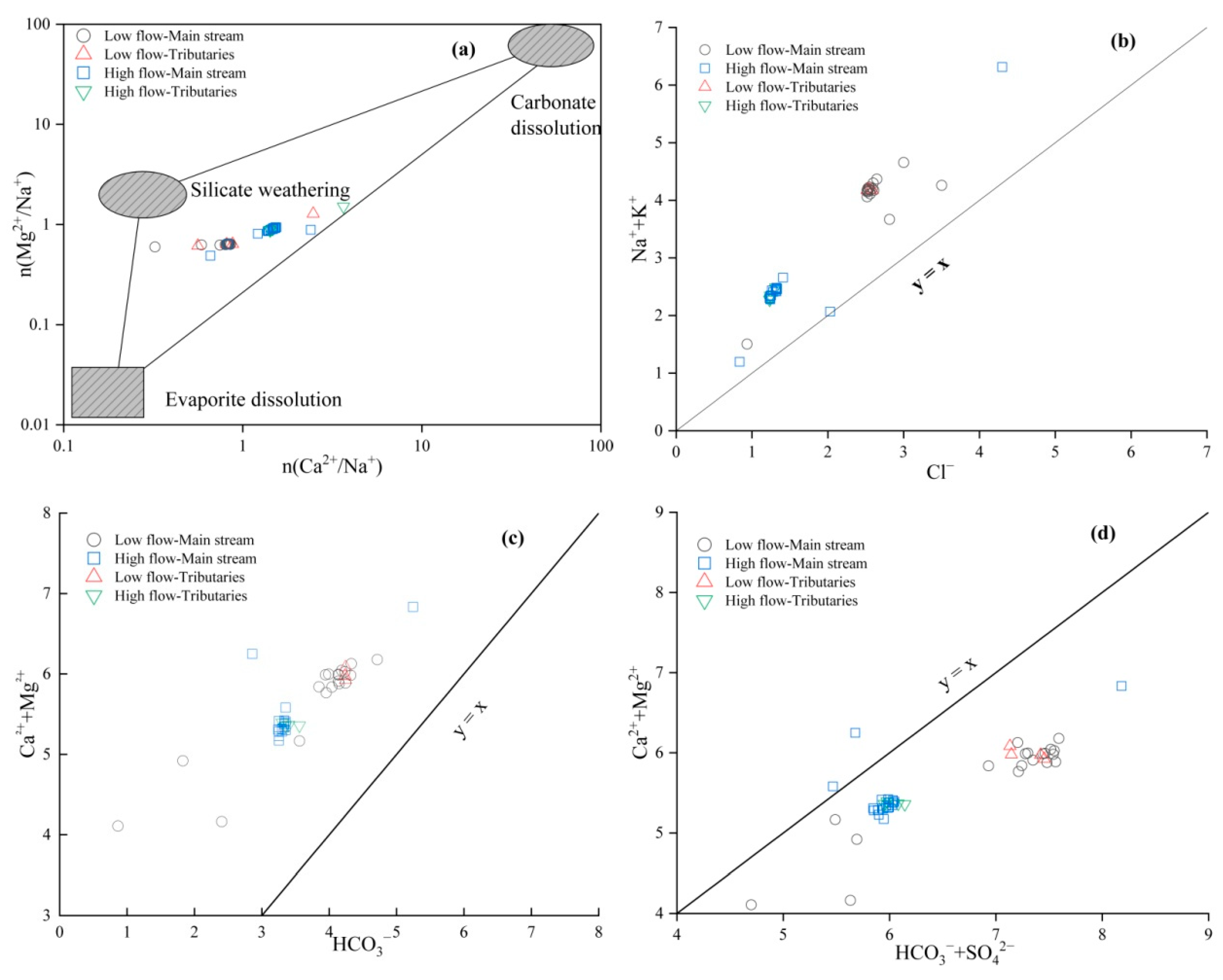Under the Strong Influence of Human Activities: The Patterns and Controlling Factors of River Water Chemistry Changes—A Case Study of the Lower Yellow River
Abstract
:1. Introduction
2. Materials and Methods
2.1. Overview of the Study Area
2.2. Sample Collection and Testing
2.3. Data Analysis
3. Results and Analysis
3.1. Characteristics of the Hydrochemical Components in the Lower Yellow River
3.2. Temporal Variation Characteristics of Hydrochemical Components in the Lower Yellow River
3.3. Spatial Variation Characteristics of Hydrochemical Components in the Lower Yellow River
4. Discussion
4.1. Comparison of Hydrochemical Components between the Lower Yellow River and Other Major Rivers, Both Domestically and Internationally
4.2. Identification of Hydrochemical Component Sources in the Lower Yellow River
4.2.1. Identification of Hydrochemical Component Sources in the Lower Yellow River Using the Gibbs Diagram
4.2.2. Sources of Hydrochemical Components in the Lower Yellow River—Ion Ratio Method
4.3. Impact of Human Activities on Hydrochemical Components in the Lower Yellow River
4.4. Identification of Dominant Factors Controlling Hydrochemistry in the Lower Yellow River
5. Conclusions
Supplementary Materials
Author Contributions
Funding
Data Availability Statement
Acknowledgments
Conflicts of Interest
References
- Zhang, Q.Q.; Zhang, J.; Wang, H.W.; Zhai, T.L.; Liu, L.; Li, G.; Xu, Z. Spatial Patterns in Water Quality and Source Apportionment in a Typical Cascade Development River in Southwestern China Using PMF Modeling and Multivariate Statistical Techniques. Chemosphere 2023, 311, 137139. [Google Scholar] [CrossRef] [PubMed]
- Nguyen, T.A.; Le, D.C.; Nguyen, T.N.; Britta, S.; Tran, L.L. Influences of key factors on river water quality in urban and rural areas: A review. Case Stud. Chem. Environ. Eng. 2023, 8, 100424. [Google Scholar]
- Ren, C.; Zhang, Q.Q. Groundwater Chemical Characteristics and Controlling Factors in a Region of Northern China with Intensive Human Activity. Int. J. Environ. Res. Public Health 2020, 23, 9126. [Google Scholar] [CrossRef] [PubMed]
- Liu, J.; Han, G.; Liu, M.; Zeng, J.; Liang, B.; Qu, R. Distribution, Sources and Water Quality Evaluation of the Riverine Solutes: A Case Study in the Lancangjiang River Basin, Tibetan Plateau. Int. J. Environ. Res. Public Health 2019, 16, 4670. [Google Scholar] [CrossRef] [PubMed]
- Wang, L.Q.; Han, X.X.; Zhang, Y.Y.; Zhang, Q.; Wan, X.M.; Liang, T.; Song, H.; Bolan, N.; Shaheen, S.M.; White, J.R.; et al. Impacts of land uses on spatio-temporal variations of seasonal water quality in a regulated river basin, Huai River, China. Sci. Total Environ. 2023, 857, 159584. [Google Scholar] [CrossRef] [PubMed]
- Ren, X.; Zhang, Z.; Yu, R.; Li, Y.; Li, Y.; Zhao, Y. Hydrochemical Variations and Driving Mechanisms in a Large Linked River-Irrigation-Lake System. Environ. Res. 2023, 225, 115596. [Google Scholar] [CrossRef] [PubMed]
- Zhang, H.Y.; Han, X.; Wang, G.C.; Mao, H.; Chen, X.L.; Zhou, L.; Huang, D.D.; Zhang, F.; Yan, X. Spatial distribution and driving factors of groundwater chemistry and pollution in an oil production region in the Northwest China. Sci. Total Environ. 2023, 875, 162635. [Google Scholar] [CrossRef] [PubMed]
- You, J.; Qi, Y.; Shao, G.; Ma, C. Geochemical Characteristics and Controlling Factors of Groundwater Chemical Composition in the Zihe River Source Area, Shandong, China. Water 2024, 16, 298. [Google Scholar] [CrossRef]
- Xie, C.; Liu, H.; Li, X.R.; Zhao, H.C.; Dong, X.Y.; Ma, K.K.; Wang, N.L.; Zhao, L.J. Spatial characteristics of hydrochemistry and stable isotopes in river and groundwater, and runoff components in the Shule River Basin, Northeastern of Tibet Plateau. J. Environ. Manag. 2024, 349, 119512. [Google Scholar] [CrossRef]
- Zhang, Q.; Zhang, D.; Zhang, F.; Xiao, J. Seasonal Variation in River Water Chemistry of the Middle Reaches of the Yellow River and Its Controlling Factors. J. Geochem. Explor. 2015, 156, 101–113. [Google Scholar] [CrossRef]
- Jiang, H.; Zhang, Q.; Liu, W.; Zhang, J.; Xu, Z. Climatic and Anthropogenic Driving Forces of the Nitrogen Cycling in a Subtropical River Basin. Environ. Res. 2021, 194, 110721. [Google Scholar] [CrossRef] [PubMed]
- Mbaye, M.L.; Gaye, A.T.; Spitzy, A.; Dähnke, K.; Gaye, B. Seasonal and Spatial Variation in Suspended Matter, Organic Carbon, Nitrogen, and Nutrient Concentrations of the Senegal River in West Africa. Limnologica 2016, 57, 1–13. [Google Scholar] [CrossRef]
- Zhang, W.; Jin, X.; Liu, D.; Lang, C.; Shan, B. Temporal and Spatial Variation of Nitrogen and Phosphorus and Eutrophication Assessment for a Typical Arid River—Fuyang River in Northern China. J. Environ. Sci. 2017, 55, 41–48. [Google Scholar] [CrossRef] [PubMed]
- Zhang, Q.Q.; Wang, H.W.; Liu, L.; Zhai, T.L.; Zhang, X.Q. Multiple Isotopes Reveal the Driving Mechanism of High NO3− Level and Key Processes of Nitrogen Cycling in the Lower Reaches of Yellow River. J. Environ. Sci. 2024, 138, 597–606. [Google Scholar] [CrossRef] [PubMed]
- Yue, F.J.; Li, S.L.; Liu, C.Q.; Zhao, Z.Q.; Ding, H. Tracing Nitrate Sources with Dual Isotopes and Long-Term Monitoring of Nitrogen Species in the Yellow River, China. Sci. Rep. 2017, 7, 506. [Google Scholar] [CrossRef] [PubMed]
- Wu, N.; Liu, S.M.; Zhang, G.L.; Zhang, H.M. Anthropogenic Impacts on Nutrient Variability in the Lower Yellow River. Sci. Total Environ. 2021, 755, 142488. [Google Scholar] [CrossRef] [PubMed]
- Wang, H.; Yang, Z.; Saito, Y.; Liu, J.P.; Sun, X.; Wang, Y. Stepwise Decreases of the Huanghe (Yellow River) Sediment Load (1950–2005): Impacts of Climate Change and Human Activities. Glob. Planet. Change 2007, 57, 331–354. [Google Scholar] [CrossRef]
- Zhang, Q.Q.; Wang, X.; Wan, W.; Hou, P.; Li, R.; Ouyang, Z. The Spatial-Temporal Pattern and Source Apportionment of Water Pollution in a Trans-Urban River. Pol. J. Environ. Stud. 2015, 24, 841–851. [Google Scholar]
- Chen, J.; Wang, F.; Xia, X.; Zhang, L. Major Element Chemistry of the Changjiang (Yangtze River). Chem. Geol. 2002, 187, 231–255. [Google Scholar] [CrossRef]
- Wang, H.W.; Zhang, Q.Q. Research Advances in Identifying Sulfate Contamination Sources of Water Environment by Using Stable Isotopes. Int. J. Environ. Res. Public Health 2019, 16, 1914. [Google Scholar] [CrossRef]
- Hu, M.; Wang, Y.; Du, P.; Shui, Y.; Cai, A.; Lv, C.; Bao, Y. Tracing the sources of nitrate in the rivers and lakes of the southern areas of the Tibetan Plateau using dual nitrate isotopes. Sci. Total Environ. 2019, 658, 132–140. [Google Scholar] [CrossRef] [PubMed]
- Taher, M.E.S.; Ghoneium, A.M.; Hopcroft, R.R.; ElTohamy, W.S. Temporal and spatial variations of surface water quality in the Nile River of Damietta Region, Egypt. Environ. Monit. Assess. 2021, 193, 1–18. [Google Scholar] [CrossRef] [PubMed]
- Neal, C.; Neal, M.; Hill, L.; Wickham, H. The water quality of the River Thame in the Thames Basin of south/south-eastern England. Sci. Total Environ. 2006, 360, 254–271. [Google Scholar] [CrossRef] [PubMed]
- Li, P.Y.; Wu, J.H.; Qian, H. Assessment of Groundwater Quality for Irrigation Purposes and Identification of Hydrogeochemical Evolution Mechanisms in Pengyang County, China. Environ. Earth Sci. 2013, 69, 2211–2225. [Google Scholar] [CrossRef]
- Jin, Z.; Qin, X.; Chen, L.; Jin, M.; Li, F. Using Dual Isotopes to Evaluate Sources and Transformations of Nitrate in the West Lake Watershed, Eastern China. J. Contam. Hydrol. 2015, 177–178, 64–75. [Google Scholar] [CrossRef] [PubMed]
- Wang, L.; Zhang, Q.Q.; Wang, H.W. Rapid Urbanization Has Changed the Driving Factors of Groundwater Chemical Evolution in the Large Groundwater Depression Funnel Area of Northern China. Water 2023, 15, 2917. [Google Scholar] [CrossRef]
- Wang, H.W.; Guo, X.J.; Zhang, Q.Q.; Li, B.Y. Evolution of Groundwater Hydrochemical Characteristics and Origin Analysis in Hutuo River Basin. Environ. Chem. 2021, 40, 3838–3845. (In Chinese) [Google Scholar]
- Mayo, A.L.; Loucks, M.D. Solute and Isotopic Geochemistry and Groundwater Flow in the Central Wasatch Range, Utah. J. Hydrol. 1995, 172, 31–59. [Google Scholar] [CrossRef]
- Zhang, Q.Q.; Wang, H.W. Assessment of Sources and Transformation of Nitrate in the Alluvial-Pluvial Fan Region of North China Using a Multi-Isotope Approach. J. Environ. Sci. 2020, 32, 9–22. [Google Scholar] [CrossRef]
- Liu, W.; Jiang, H.; Guo, X.; Li, Y.; Xu, Z. Time-Series Monitoring of River Hydrochemistry and Multiple Isotope Signals in the Yarlung Tsangpo River Reveals a Hydrological Domination of Fluvial Nitrate Fluxes in the Tibetan Plateau. Water Res. 2022, 225, 119098. [Google Scholar] [CrossRef]
- Xue, D.; Botte, J.; Baets, B.D.; Accoe, F.; Nestler, A.; Taylor, P.; Boeckx, P. Present Limitations and Future Prospects of Stable Isotope Methods for Nitrate Source Identification in Surface and Groundwater. Water Res. 2009, 43, 1159–1170. [Google Scholar] [CrossRef] [PubMed]





| Parameters | pH | K⁺ | Na⁺ | Ca2⁺ | Mg2⁺ | Cl− | SO₄2− | HCO₃− | NO₃− | TDS | |
|---|---|---|---|---|---|---|---|---|---|---|---|
| Mainstream | Min (mg/L) | 7.09 | 3.74 | 50.1 | 62.1 | 24.1 | 43.8 | 124 | 198 | 11.1 | 437 |
| Max (mg/L) | 8.10 | 4.29 | 98.1 | 71.5 | 31.9 | 94.0 | 163 | 288 | 18.2 | 608 | |
| Mean (mg/L) | 7.42 | 3.96 | 74.3 | 66.8 | 28.0 | 69.2 | 141 | 230 | 15.1 | 529 | |
| SD (mg/L) | 0.313 | 0.148 | 20.7 | 1.69 | 3.33 | 22.6 | 14.5 | 27.0 | 2.15 | 70.8 | |
| CV (%) | 4.22 | 3.75 | 27.8 | 2.53 | 11.9 | 32.7 | 10.3 | 11.7 | 14.2 | 13.4 | |
| Tributary | Min (mg/L) | 7.09 | 3.80 | 24.9 | 29.3 | 19.6 | 29.8 | 92.6 | 52.8 | 7.94 | 371 |
| Max (mg/L) | 8.14 | 14.21 | 137 | 91.3 | 34.8 | 153 | 186 | 320 | 23.2 | 731 | |
| Mean (mg/L) | 7.65 | 6.74 | 70.9 | 62.5 | 26.1 | 83.0 | 140 | 180 | 15.7 | 497 | |
| SD (mg/L) | 0.35 | 3.11 | 36.7 | 20.2 | 5.47 | 42.2 | 31.9 | 74.6 | 5.18 | 103 | |
| CV (%) | 4.57 | 46.1 | 51.8 | 32.4 | 20.9 | 50.9 | 22.8 | 41.5 | 33.1 | 20.8 | |
| River | K+ + Na+ | Ca2+ | Mg2+ | SO42− | Cl− | NO3− |
|---|---|---|---|---|---|---|
| This study | 60.1 | 64.1 | 26.2 | 106 | 64.2 | 15.1 |
| Yangtze River [19] | 8.20 | 34.1 | 7.60 | 11.7 | 2.90 | 3.44 |
| Lancang River [1] | 20.6 | 48.17 | 10.72 | 63.01 | 24.8 | 2.52 |
| Yarlung Tsangpo River [21] | — | — | — | 29.6 | 3.29 | 0.54 |
| Nile Delta [22] | 44.8 | 40.0 | 16.6 | 30.1 | 36.4 | 20.1 |
| Thames River [23] | 9.40 | 39.0 | 124 | 5.60 | 73.3 | 21.9 |
| Parameters | PC1 | PC2 |
|---|---|---|
| K⁺ | 0.966 | −0.137 |
| Cl⁻ | 0.962 | 0.099 |
| HCO₃⁻ | −0.957 | −0.255 |
| Ca2⁺ | −0.759 | −0.607 |
| SO₄2⁻ | 0.707 | −0.209 |
| TDS | −0.674 | −0.516 |
| Na⁺ | 0.227 | 0.922 |
| Mg2⁺ | −0.155 | 0.875 |
| NO₃⁻ | 0.001 | 0.621 |
| Eigenvalue | 4.81 | 2.34 |
| Total variance (%) | 53.5 | 26.0 |
| Cumulative (%) | 53.5 | 79.5 |
| Parameters | PC1 | PC2 |
|---|---|---|
| SO₄2⁻ | 0.992 | −0.029 |
| Mg2⁺ | 0.991 | 0.001 |
| TDS | 0.988 | 0.052 |
| Cl⁻ | 0.987 | −0.116 |
| Na⁺ | 0.983 | −0.167 |
| HCO₃⁻ | 0.934 | 0.097 |
| K⁺ | 0.855 | −0.331 |
| Ca2⁺ | 0.226 | 0.954 |
| NO₃⁻ | −0.366 | 0.898 |
| Eigenvalue | 6.74 | 1.82 |
| Total variance (%) | 74.9 | 20.2 |
| Cumulative (%) | 74.9 | 95.1 |
Disclaimer/Publisher’s Note: The statements, opinions and data contained in all publications are solely those of the individual author(s) and contributor(s) and not of MDPI and/or the editor(s). MDPI and/or the editor(s) disclaim responsibility for any injury to people or property resulting from any ideas, methods, instructions or products referred to in the content. |
© 2024 by the authors. Licensee MDPI, Basel, Switzerland. This article is an open access article distributed under the terms and conditions of the Creative Commons Attribution (CC BY) license (https://creativecommons.org/licenses/by/4.0/).
Share and Cite
Ren, C.; Liu, L. Under the Strong Influence of Human Activities: The Patterns and Controlling Factors of River Water Chemistry Changes—A Case Study of the Lower Yellow River. Water 2024, 16, 1886. https://doi.org/10.3390/w16131886
Ren C, Liu L. Under the Strong Influence of Human Activities: The Patterns and Controlling Factors of River Water Chemistry Changes—A Case Study of the Lower Yellow River. Water. 2024; 16(13):1886. https://doi.org/10.3390/w16131886
Chicago/Turabian StyleRen, Chaobin, and Lu Liu. 2024. "Under the Strong Influence of Human Activities: The Patterns and Controlling Factors of River Water Chemistry Changes—A Case Study of the Lower Yellow River" Water 16, no. 13: 1886. https://doi.org/10.3390/w16131886




